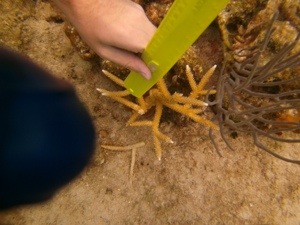Day 3
Great third day in the BVI. I woke up bright and early at 7 to numerous bird sounds. They were very loud and obnoxious. After a quick shower, I headed down to the commissary to have breakfast. It consisted of assorted fruits, pop tarts, donuts, and yogurt. Staying at the commissary, we were then lectured by Dr. Shannon Gore (same ones yesterday). She taught us all about sea turtles. They have been around for over two and a half million years and are now narrowed down to seven different species. Only four of those are found near/in the BVI: Hawksbill, Green, Loggerhead, and Leatherback. Hawksbill and Green Turtles are found dwelling in the BVI while Loggerheads and Leatherbacks really only nest here. All sea turtle species are on the decline and nearing extinction, so tagging them is an important task. Tagging allows you to not only allows you to measure the turtle but also allows you to track its movements. Later in the day we would tag the turtles.
After the lesson we were picked us up by Glen who took us to the marina. We then boarded Sea Dragon to embark on our turtle tagging adventure. There are three ways to catch turtles: nets, rodeo style” (jumping off the boat onto the turtle), and mantito (hanging onto rope being towed by the boat). We used mantito at Guana Island, a place where sea turtles usually dwell. We did this for about and hour and a half, then headed to an area around Virgin Gorda north of the marina. We unfortunately caught no turtles and saw no turtles; however, the second group (the Marine 1 guys) did catch one turtle. Though it was unsuccessful, it was fun being towed and looking for turtles.
Turtle tagging was followed by lunch at a restaurant at the marina. We all had delicious burgers. I have found a new liking for ketchup. After lunch we walking around Spanish Town where we entered the grocery store and looked around. Christian and Buck are thinking about buying a 36 pack of Brisk. We then boarded Sea Dragon and setup our SCUBA gear.
We headed to our Jesuit Reef where last year we transplanted coral with zip ties. Our task was to measure and take pictures of the elkhorn and staghorn that we planted last year. The depth was 15-25 feet which meant that we could last a lot longer. The dive ended up being around 60 minutes and we swam without instructors. This meant that it was just Joe, Christian, and I. The dive was pretty fun but also tricky because our buoyancy needed to be perfect to ensure the protection of the coral. We ended up recording around 20 pieces of coral; it was very hard because the labels had been covered in algae. However, we persevered and had a very successful dive.
After the dive we headed back to the marina where Glen was waiting for us. We packed, then headed back to Guavaberry for asagna hit the spot. Another great day and I can’t wait for tomorrow.






